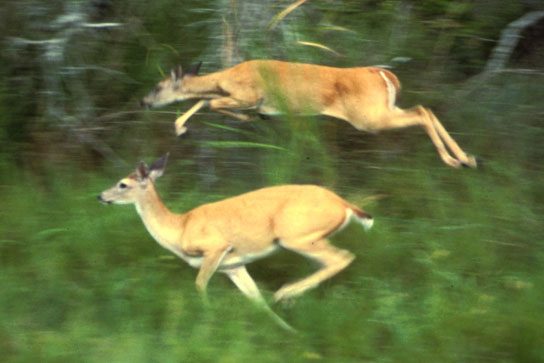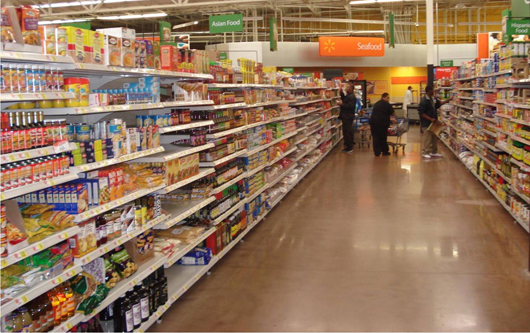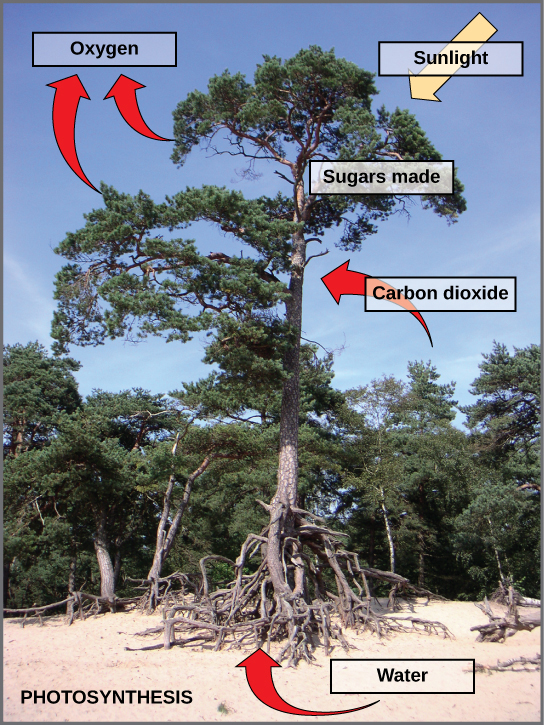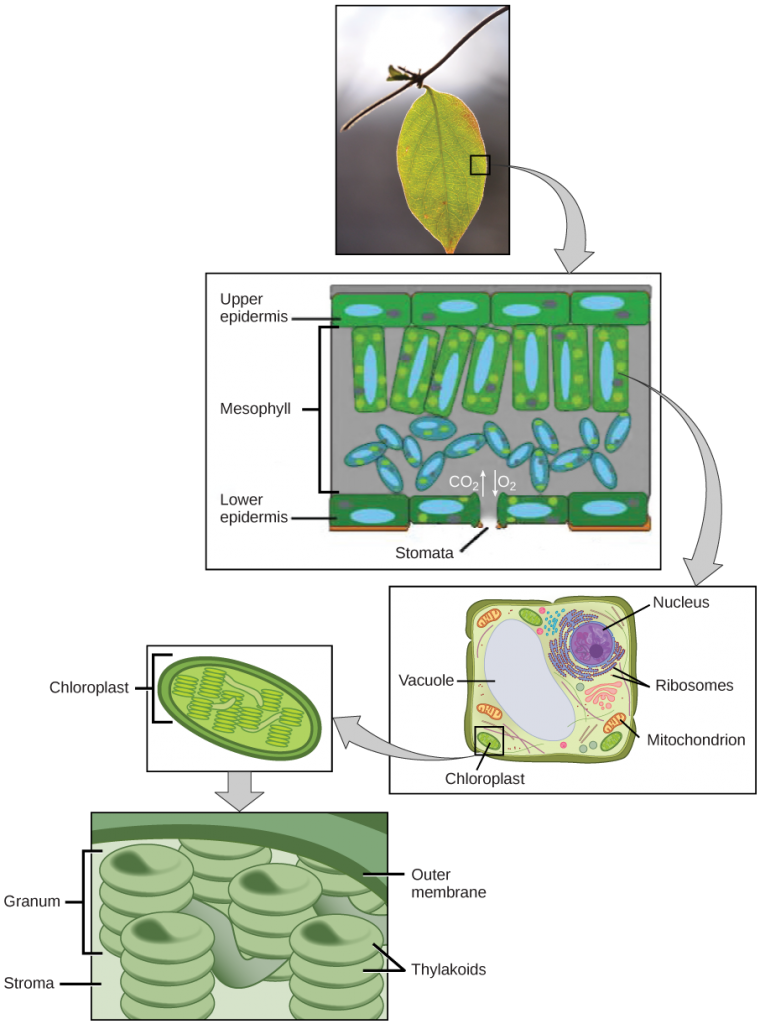Chapter 4 Review and Assessment the Organelle in Which Photosynthisis Takes Place
Chapter 5: Introduction to Photosynthesis
5.1: Overview of Photosynthesis
Learning Objectives
By the stop of this section, you will be able to:
- Summarize the process of photosynthesis
- Explain the relevance of photosynthesis to other living things
- Identify the reactants and products of photosynthesis
- Describe the master structures involved in photosynthesis
All living organisms on world consist of i or more than cells. Each jail cell runs on the chemical energy found mainly in carbohydrate molecules (food), and the majority of these molecules are produced by one process: photosynthesis. Through photosynthesis, sure organisms convert solar energy (sunlight) into chemic energy, which is then used to build carbohydrate molecules. The free energy used to agree these molecules together is released when an organism breaks down food. Cells then use this energy to perform work, such as cellular respiration.
The energy that is harnessed from photosynthesis enters the ecosystems of our planet continuously and is transferred from one organism to some other. Therefore, straight or indirectly, the process of photosynthesis provides about of the energy required by living things on earth.
Photosynthesis besides results in the release of oxygen into the atmosphere. In short, to eat and breathe, humans depend almost entirely on the organisms that conduct out photosynthesis.
Concept in Action

Click the following link to acquire more well-nigh photosynthesis.
Solar Dependence and Nutrient Production
Some organisms can carry out photosynthesis, whereas others cannot. An autotroph is an organism that tin can produce its ain food. The Greek roots of the word autotroph hateful "cocky" (auto) "feeder" (troph). Plants are the best-known autotrophs, simply others exist, including certain types of leaner and algae (Figure 5.2). Oceanic algae contribute enormous quantities of nutrient and oxygen to global food chains. Plants are also photoautotrophs, a type of autotroph that uses sunlight and carbon from carbon dioxide to synthesize chemical energy in the form of carbohydrates. All organisms carrying out photosynthesis crave sunlight.

Heterotrophs are organisms incapable of photosynthesis that must therefore obtain free energy and carbon from food by consuming other organisms. The Greek roots of the word heterotroph hateful "other" (hetero) "feeder" (troph), meaning that their nutrient comes from other organisms. Fifty-fifty if the food organism is another animal, this nutrient traces its origins back to autotrophs and the process of photosynthesis. Humans are heterotrophs, as are all animals. Heterotrophs depend on autotrophs, either directly or indirectly. Deer and wolves are heterotrophs. A deer obtains energy by eating plants. A wolf eating a deer obtains energy that originally came from the plants eaten by that deer. The energy in the plant came from photosynthesis, and therefore information technology is the simply autotroph in this case (Figure 5.3). Using this reasoning, all nutrient eaten by humans likewise links back to autotrophs that carry out photosynthesis.

Biology in Action
Photosynthesis at the Grocery Store

Major grocery stores in the United States are organized into departments, such as dairy, meats, produce, breadstuff, cereals, and then forth. Each alley contains hundreds, if not thousands, of different products for customers to purchase and consume (Figure 5.iv).
Although in that location is a large variety, each item links dorsum to photosynthesis. Meats and dairy products link to photosynthesis because the animals were fed institute-based foods. The breads, cereals, and pastas come up largely from grains, which are the seeds of photosynthetic plants. What about desserts and drinks? All of these products contain sugar—the basic saccharide molecule produced directly from photosynthesis. The photosynthesis connection applies to every meal and every food a person consumes.
Primary Structures and Summary of Photosynthesis
Photosynthesis requires sunlight, carbon dioxide, and water as starting reactants (Effigy 5.5). After the process is complete, photosynthesis releases oxygen and produces carbohydrate molecules, near commonly glucose. These sugar molecules contain the energy that living things demand to survive.

The circuitous reactions of photosynthesis tin be summarized by the chemic equation shown in Figure 5.6.

Although the equation looks unproblematic, the many steps that accept place during photosynthesis are actually quite complex, as in the way that the reaction summarizing cellular respiration represented many individual reactions. Before learning the details of how photoautotrophs plough sunlight into food, it is important to get familiar with the concrete structures involved.
In plants, photosynthesis takes place primarily in leaves, which consist of many layers of cells and have differentiated superlative and lesser sides. The process of photosynthesis occurs non on the surface layers of the leaf, but rather in a center layer called the mesophyll (Figure 5.7). The gas exchange of carbon dioxide and oxygen occurs through small, regulated openings called stomata.
In all autotrophic eukaryotes, photosynthesis takes place inside an organelle chosen a chloroplast. In plants, chloroplast-containing cells exist in the mesophyll. Chloroplasts take a double (inner and outer) membrane. Within the chloroplast is a third membrane that forms stacked, disc-shaped structures called thylakoids. Embedded in the thylakoid membrane are molecules of chlorophyll, a pigment (a molecule that absorbs light) through which the entire process of photosynthesis begins. Chlorophyll is responsible for the green colour of plants. The thylakoid membrane encloses an internal space called the thylakoid infinite. Other types of pigments are also involved in photosynthesis, but chlorophyll is by far the most of import. As shown in Figure five.7, a stack of thylakoids is chosen a granum, and the infinite surrounding the granum is chosen stroma (non to exist confused with stomata, the openings on the leaves).

On a hot, dry out day, plants close their stomata to conserve water. What touch volition this have on photosynthesis?
The Two Parts of Photosynthesis
Photosynthesis takes place in two stages: the light-dependent reactions and the Calvin cycle. In the light-dependent reactions, which have place at the thylakoid membrane, chlorophyll absorbs free energy from sunlight and then converts information technology into chemical energy with the utilise of water. The light-dependent reactions release oxygen from the hydrolysis of h2o as a byproduct. In the Calvin wheel, which takes place in the stroma, the chemic energy derived from the low-cal-dependent reactions drives both the capture of carbon in carbon dioxide molecules and the subsequent assembly of sugar molecules. The two reactions use carrier molecules to transport the free energy from one to the other. The carriers that move energy from the light-dependent reactions to the Calvin bicycle reactions can be thought of as "full" considering they bring free energy. Subsequently the energy is released, the "empty" free energy carriers return to the light-dependent reactions to obtain more than energy.
Section Summary
The procedure of photosynthesis transformed life on earth. By harnessing free energy from the sun, photosynthesis immune living things to access enormous amounts of free energy. Because of photosynthesis, living things gained admission to sufficient free energy, assuasive them to evolve new structures and attain the biodiversity that is axiomatic today.
Only certain organisms, chosen autotrophs, can perform photosynthesis; they crave the presence of chlorophyll, a specialized pigment that tin can blot light and convert light energy into chemic energy. Photosynthesis uses carbon dioxide and water to assemble carbohydrate molecules (usually glucose) and releases oxygen into the air. Eukaryotic autotrophs, such equally plants and algae, have organelles called chloroplasts in which photosynthesis takes identify.
Glossary
autotroph: an organism capable of producing its own food
chlorophyll: the green paint that captures the low-cal free energy that drives the reactions of photosynthesis
chloroplast: the organelle where photosynthesis takes identify
granum: a stack of thylakoids located inside a chloroplast
heterotroph: an organism that consumes other organisms for nutrient
light-dependent reaction: the first phase of photosynthesis where visible light is absorbed to form ii energy-carrying molecules (ATP and NADPH)
mesophyll: the eye layer of cells in a leaf
photoautotroph: an organism capable of synthesizing its ain food molecules (storing free energy), using the energy of light
pigment: a molecule that is capable of absorbing low-cal energy
stoma: the opening that regulates gas substitution and h2o regulation between leaves and the environment; plural: stomata
stroma: the fluid-filled space surrounding the grana within a chloroplast where the Calvin cycle reactions of photosynthesis accept place
thylakoid: a disc-shaped membranous structure inside a chloroplast where the light-dependent reactions of photosynthesis have place using chlorophyll embedded in the membranes
Source: https://opentextbc.ca/biology/chapter/5-1-overview-of-photosynthesis/